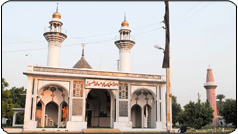Talkatora Karbala & Imambara Kaiwan Jah
On tha day of Aashura (10th Muharrum) and Chehellum (20th Safar), the city witnesses groups of men, women and children, clad in black, moving towards the Karbala at Tal Katora near Aish Bagh, to bury their taazia. The Karbala was built by Mir Khuda Bakhsh. On these two days, the place also serves as an assembly point for anjumans that come here with alam (the replica of the banner of Imam Hussain's army) to perform maatam (beating their chest) to mourn the martyrdom of Imam Hussain and his 72 followers. Some devotees also perform the zanjeer ka maatam (flagellation with knives attached to chains).
Before the construction of Karbala of Mir Khuda Bakhsh, there were two other Karbalas in the city, one built by Khwajasara llmas Ali Khan in Nawab Asaf-ud-Daulah's reign and the other built by Haji Masita during the reign of Nawab Saadat Ali Khan. Both these Karbalas are no longer extant, but the ruins of latter may be seen adjacent to the Tal Katora Karbala.
Mir Khuda Bakhsh started his career in the service of Khwajasara Afreen Ali Khan who was quite close to Asaf-ud-Daulah. His interest in theology and religion made him become a disciple of Syed Dildar Ali Naqvi, the Shia mujtahid and earliest propagator of Azadari (mourning rituals) in Lucknow. He was posthumously titled as Ghufran Maab by his followers. [His Imambara in the city is internationally known for its Shaam-e-Ghariban majlis, held in the dark after sunset, on Aashura]. Later Khuda Bakhsh also became a close confident of Muatamad-ud-Daulah Agha Mir, who became the Prime Minister of Awadh when Ghazi-ud-Din Haider became the first King of Awadh. Mir Khuda Bakhsh faced problems on the demise of an infant daughter, whom he finally managed to bury at the Karbala of llmas Ali Khan. Thereafter, he thought of building a Karbala on his own which would be accessible for burial to common people as weil. He purchased 30 bigha of land from Kaptan Hasan Ali and commenced the construction of the Karbala on the birth anniversary of Hazrat Ali on Rajab 13, in 1232 Hijri (1817), during the reign of Nawab Ghazi-ud-Din Haider. Under the supervision of Sadiq Ali Zair, the construction was completed within six months. The Persian taareekh (chronogram) for the construction is fixed on the west-side gateway of the quadrangle of the Karbala which bears the name of the ruler Ghazi-ud-Din Haider with that of the builder Mir Khuda Bakhsh and his patron Afreen Ali Khan.
The upper portion of the main structure of this Karbala (the gilded domes and minarets) appear to be a good copy of the Rauza (mausoleum) of Imam Hussain at Karbala, in Iraq. A quadrangle bounded with arched compartments with gateways in the middle on all its four sides, serves as a burial ground and graveyard. It has calligraphic inscriptions of Quranic verses inscribed all over the panels provided on the inner side of the boundary walls. The Rauza also has inscriptions of Quranic verses that appear all around, on the top borders of its exteriors. [Calligraphic logos may also be seen in the ceiling of the hall of the Rauza].
An interesting feature seen on one corner of the quadrangle is a (free standing) tall tower, meant for the muazzin for giving azaan, the call for prayers, which is built in the style of towers of the madarsa of Samarqand. (A similar tower can also be seen with the mosque of Karbala Dayanat-ud-Daulah).
Towards the west, there is a crumbling octagonal structure covered with a dome which is called Khema-gah, which was probably meant for delivering sermons pertaining to the rituals connected with the burial of taazia on Aashura and Chehellum.
The tripolia (three-arched gateway) on the road to Rajajipuram, serves as the main entrance to the Karbala. It faces the Imambara of Kaiwan Jah, which is ornamented with beautiful foliage and floral designs and borders of exquisite calligraphic inscriptions of Quranic verses, that are painted on the inside walls of its halls. Stucco mouldings embellish the arches and pillars of the two halls and shahnashin of the Imambara.The flora! decoration and calligraphy is also there, in stucco, on the facade.
Earlier, almost every noble of the Nawabi days had his own family graveyard in which they buried their taazia (and the corpses of their family members). However, after the 1857-58 conflict, the British, apart from some rare exceptions, made it mandatory to bury all taazias in the Karbala of Mir Khuda Bakhsh and thus it gained a special status and importance. It was till 1907 that both Shia and Sunni Muslims took their taazia to this Karbala. However, after conflict between the two sects in that year (1907), the latter began taking their taazia to Phool Katora at Badshah Nagar.
Source:
Hindustan Times, City Scan, A Time in History
Wednesday 2.6.1999 — Unburying the past

